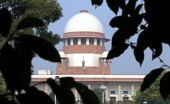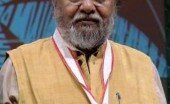2011: The year when the Judicial Activism debate ended.
Written by Alok // December 30, 2011 // Law & The Judiciary // 1 Comment
(This is not strictly a review of all things last year, but more of a personal take on the main events of the past year focusing more on the Supreme Court of India and events in India broadly stitched around a theme)
This time last year, Kim Jong Il, Muammar Gaddhafi and Hosni Mubarak were the most powerful men in their respective countries.
Anna Hazare was barely known outside the state of Maharashtra; Arvind Kejriwal probably not beyond his immediate family.
Justice Kapadia had just promised to cut down on judicial activism in favour of clearing the massive backlog of cases in the Supreme Court of India.
Most people couldn’t spell or even pronounce Kanimozhi.
How things change in 365 days.
Well ok, except for the last thing.
How do we make sense of these tectonic changes?
That these changes have been tectonic can’t be denied. The Lokpal debate and the 2G and Commonwealth Games scams and the Government’s response in tackling have fundamentally altered the way citizens view the institutions of State. It may not be evident to us now. After all, we still put up the same nonsense at Government offices, still have Parliament being repeatedly made a mockery of by its own legislators and feel the effects of ill thought out and poorly implemented policies. On the surface, nothing’s really changed. Or so it seems. But undeniably, and even the most ostrich of persons would not deny this, something has changed in the national discourse this year.
A simple answer in one word: corruption.
Or even more simply, the giving and taking of bribes by government servants for performing their functions.
It’s a partial answer and a very incomplete one at that. Corruption is about as old as the State. To repeat Chanakya’s oft-repeated quote: “…It is impossible to know when a fish moving in water is drinking it…” Yet, this saying offers us only a partial answer of what government is, and not what it ought to be.
Chanakya’s use of analogy was not just to state the obvious in an interesting manner, but to further a complex and nuanced argument. Corruption is almost a given in an institution such as the government, but that doesn’t mean no efforts should be made to minimize or eradicate it. Rather, Chanakya’s analogy was an attempt to uncover the nature of government itself that led it to corruption.
Government (like a corporation) essentially involves dealing with other people’s property and money. How you raise it, what you use it for and who gets what are the basics of governance and the answers differ on the basis of one’s ideology and the needs of a given time, but no Government can function without doing these two essential things; raising money and spending it.
So much for the “is”.
But Chanakya also answers the “ought”; government ought to mean spending the income wisely for the welfare of the people. For, as Chanakya states repeatedly, only in the welfare of the people lies the welfare of the King (or Government if you prefer). It seems obvious enough, yet only in restating and understanding the “ought” do we get to the heart of why corruption has become the issue it has now.
As citizens, this “ought” is fundamental to why we part with our money to the Government (or perhaps our property for due compensation). The compact between Government and citizen should seem so obvious that it doesn’t need restating but it is a reflection of these times that this particular compact has to be restated. What the Lokpal Bill agitation and the Commonwealth and 2G Scam highlight are the very real threats this compact faces from corruption.
For people in their twenties and thirties, it would seem that this is the first time this has happened so.
Those with longer memories would know that the unearthing of massive corruption scandals is nothing new, nor the jailing of MPs, CMs and ministers. Not even judicial activism to fight corruption.
What’s changed this time is that where perhaps corruption was seen as an aberration to the norms of governance, the brazenness and the scale at which the Commonwealth Games and 2G scams were carried out would suggest that perhaps corruption has, far from being an anomaly in the system (to use a Matrix-ism) is in fact, the system itself. That there is no concept of public welfare anymore, and that the government exists to serve its clients – those who can pay the price and no others.
This loss of faith in government explains the agitation around the Lokpal Bill but also the land acquisition agitation in UP. Where the UP agitation was aimed at one particularly egregious misuse of governmental powers to openly benefit real estate developers at the expense of farm owners, the Lokpal agitation was sparked off mainly because it seemed that far from ensuring that a scam of the scale of the 2G scam or the Commonwealth scam never happened, the Government of the day tried to protect the corrupt through a weak and ineffective institution.
It’s easy to dismiss the “civil society” and Anna Hazare as a bunch of middle class busybodies who’ve been given undue importance thanks to a hyperactive “corporate” media.
It’s also demonstrably false.
The crowds streaming into Jantar Mantar and Ramlila Maidan in the middle of the year were not bused in and promised money and food (as many political rallies are wont to). You couldn’t classify and categorize them all under one neat socio-economic or religious label.
Yet, as if almost on cue, when Anna couldn’t “deliver” on the crowds (read “spectacle”) the media turned on him. Hardly the hallmark of a media driven campaign.
Still, what relevance does all of this have to the events of the past year in the law and the judiciary?
It has, I think, fundamentally changed the contours of the judicial activism debate. If one of the underlying premises of the institutional competence argument (as opposed to constitutional competence, more of which in a separate piece perhaps) is that government is capable of doing some things “better”, and therefore the Courts must not “meddle”, the actions of the government over the last year have called this assumption very much into question. The sorry saga of inaction, incompetence and just plain mendacity on the part of the government that was revealed in not just the mega scams but also in such issues as the right to food litigation, the black money litigation and the tax waivers for the F1 race. In the face of such a sorry state of affairs, the option is between institutional encroachment and complete and utter breakdown of the rule of law.
What has happened is that when the citizen’s faith in the government’s ability to act in the public welfare (as opposed to his or her individual welfare) itself stands questioned, the Court has, on the instance of such citizens stepped in to ensure that government acts in such a manner. In one sense, and this merits much more scrutiny than this post can possibly hope to provide, a very discernible shift is obvious in the manner in which the Supreme Court goes about its activism. No longer is activism about merely issuing writs and directions enforcing rights (howsoever defined, and yes I’m aware there’s nothing “mere” about enforcing rights, but bear with me) but also at ensuring that the government complies with its duties and obligations to the public at large.
Two very different cases, the Bellary Mining ban and the CVC case are possibly the best indicators of this (though a more comprehensive study would also include all the PILs not entertained at the threshold itself but this is not the place for it). The dominant discourse in the decisions is about protecting larger public interest and welfare in the face of State and Central Government failure to do the same. A State Government had failed to check the rampant illegal mining and ecological destruction of Bellary. The Central Government had cynically appointed an officer who faced a criminal charge of corruption as the head of the anti-corruption body. These were not instances of the Government choosing a good or bad course of action – it was a case of complete and total dereliction of duty that could not be justified with anything more than a bland ipse dixit.
In that sense, this year has probably set off a subtle yet significant shift in the Court’s understanding of its own role and the manner in which it articulates its role. Apart from being a defender of rights (fundamental, legal and constitutional) and upholder of the rule of law, it has also adopted the role of protector of the public welfare at large. Not that this is a new legal argument that is being made in Courts or that we are speaking of a new and hitherto unseen aspect of judicial review, but in terms of the Supreme Court’s role in the larger polity this is perhaps a significant (and not a few would say, welcome) shift that could take us down new and interesting paths in the history of the Indian judiciary.
Yet, this is no time for the Court to rest on its laurels (hard won though they may be). Although the battle against delays seems a Sisyphean labour at best, the spectre of large scale judicial corruption has never hung heavier over the judiciary. Though the cases of Soumitra Sen, PD Dinakaran and Nirmal Yadav came to light last year, serious action has only taken place this year.
It is no longer a case of black sheep here and there. There is a flock of dark fleece threatening to taint the whole judiciary. Indeed the illegal land allotment to judges, past and present, in Bangalore has exposed more than a few skeletons in closets. The distressing silence on the part of most of the judges involved has only fuelled further doubts about their integrity. The malaise Justice Markandeya Katju outlined with much anguish earlier this year with reference to Allahabad High Court threatens to engulf the entire upper judiciary if not stopped adequately. For the Court to retain its credibility as the foremost defender of the rule of law in this country, it must, to use a Biblical proverb, “remove the speck in its own eye.”
What does the New Year hold for us lawyers and the judiciary?
Definitely a new Chief Justice of India in September (Justice Altamas Kabir according to seniority). The Vodafone verdict, the Right to Education ruling and perhaps most importantly, the order deciding whether or not Home Minister P Chidambaram should be investigated in the 2G scam. The trial will of course continue in the Patiala House court in Delhi and we’ll all receive breathless reports of the proceedings from over-keen reporters some of whom may even have legal training!
The Lokpal Bill will probably be introduced once again in Parliament in April but no one really believes that the Government genuinely wants to tackle corruption at the highest levels. Parliament’s alleged “supremacy” already a hollow doctrine in Constitutional law, has been stripped of even more legitimacy in the light of today’s events.
As the old Chinese curse goes, we are living in interesting times. Despondence seems to be the national mood, despair a national pre-occupation and disappointment (for cricket fans and Sensex watchers alike) leaving a bitter aftertaste at the end of the year.
With all the bleakness above, perhaps I should end on a positive note.
As it turns out, the Mayans were wrong! The world won’t end in 2012.
Happy New Year to all!




One Comment on "2011: The year when the Judicial Activism debate ended."
congratulations. this is an excellent article which reflects the opinion of well educted and well informed people of this country